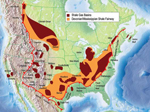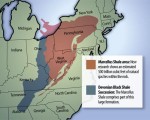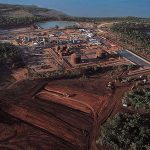Fracking-Earthquake Link Known For Decade By Scientists, Military and Frackers
Fracking and quaking: they’re linked
And scientists, the military, and frackers themselves have known it for years
By Andrew Nikiforuk
The Tyee
The next time a Canadian consumer turns up their natural gas furnace or clicks on that gas burner, he or she may have inadvertently triggered an earthquake. Or a swarm of earthquakes.
Although the Canadian Gas Association calls methane a versatile, abundant and safe fuel, its unconventional cousin, shale gas, has been shaking the ground all the way from Lancashire, England to Dallas, Texas.
Shale gas drilling has also been associated with earthquakes in Arkansas, Alberta, and Oklahoma too. And now, even B.C.’s Oil and Gas Commission is investigating 31 tremors with magnitudes as great as 4.3 that have shaken the Horn River shale gas play near Fort Nelson, B.C. since 2009.
Three of the quakes occurred during controversial hydraulic fracking operations.
“There hasn’t been a link between the hydraulic fracturing and anomalous seismic activity, but we wanted to take a proactive approach,”
explained Hardy Friedrich, a spokesman of the OGC earlier in the month.
The U.S., however, identified hydraulic fracturing as an earthquake trigger as early as 1990. In fact, the oil and gas industry has been triggering earthquakes for more than 50 years. Moreover, shale gas activity, which drills and injects fluid much deeper into the earth’s crust at higher pressures than normal, has set off a remarkable string of man-made tremors — all with uncertain impacts.
Shale’s seismic shake-ups
To date, most of the incidents appear to be strongly associated with high-pressure disposal of wastewater from shale gas wells.
In fact, the phenomenon has become so dramatic in booming shale gas regions that regulators, policy makers and ordinary landowners are getting truly rattled.
The number of mini-quakes in highly drilled Alberta alone has increased so demonstrably in recent decades (from 60 to more than 200 a decade) that the government launched a project
“to document and understand their relationship to oil and gas production.”
Similar concerns are arising throughout the U.S.
“If not addressed properly induced seismicity could unduly delay and cancel important energy applications,”
warned an expert at the U.S. Lawrence Berkeley National Laboratory.
At the centre of man-made seismic activity lies brute force used by the shale gas industry. It routinely employs hydraulic fracturing, a technology that sends highly-pressurized blasts of sand, chemicals and millions of gallons of water into deep rocks.
In fact, the industry actually induces small and controlled “micro seismic” events to release methane stubbornly trapped in rock as dense as concrete.
But after fracking, the industry must pump up its chemical fluids and other existing water back to surface. The resulting brew typically contains salt, radioactive materials, toxic fracking chemicals and heavy metals. To get rid of it, industry re-injects the fluid back in the ground at depths of one to four kilometers via injection wells.
Not new that fluid blasts cause quakes
Scientists, however, have known for a long time that fluid injection a few kilometres deep into the ground can cause earthquakes, because that’s where the Earth’s crust lies closest to faults and fractures.
The U.S. military accidentally proved that fluid injection can stress existing faults in the 1960s at the Rocky Mountain Arsenal outside of Denver, Colorado, with spectacular consequences.
In 1962, the military started pumping chemical waste into a disposal well drilled two miles underground. The injection of fluids then triggered an astounding 1,500 earthquakes between 1962 and 1967.
After the military stopped injecting waste due to protests, three earthquakes greater than 5 on the Richter scale rocked Denver area, resulting in more than $8-million worth of property damage. Scientists later blamed the earthquakes on fluid injection that unbalanced an existing fault or fracture.
A decade later, after the rapid depletion of sour gas pools near the Strachan Gas plant outside of Rocky Mountain House, Alberta triggered 143 earthquakes in 23 days with magnitudes as great as 3.5.
Concluded a 1985 Canadian federal report:
“The earthquakes are not induced by fluid injection but more likely by depletion of the reservoir through gas extraction.”
The event proved to experts that pumping stuff out of the ground could cause notable seismic activity as great as pumping it into the ground.
In the 1980s, another cluster of earthquakes shook oil fields in Fort St. John, B.C. The region had no history of seismic activity. All of the quakes occurred after industry flooded reservoirs with water to recover hard-to-get oil.
The first cluster of earthquakes shook the region in 1984 and could be felt 2,000 kilometres away. Another cluster with a magnitude as high as 3.5 occurred in the 1990s right in the oil production area.
Concluded researchers in the Canadian Journal of Exploration Geophysics in 1994:
“there do appear to be spatial and temporal correlations between the earthquakes and oil production in the Eagle West and Eagle fields. Fluid injection in particular must be considered as a possible cause.”
By 1990, the U.S. Environmental Protection Agency had even identified the practice of hydraulic fracturing and fluid injection as earthquake triggers and recommended extensive seismic monitoring.
Noted the EPA report on man-made earthquake hazards and deep well injection:
“If earthquakes thought to be related to injection operations are detected, then the following questions are appropriate: Is it possible that induced earthquakes might cause damage or injury in the surrounding area? and is it possible that the earthquakes indicate fault displacement that might threaten the integrity of the confining zone?
If the answer to either of these questions is ‘yes,’ then consideration should be given to reducing the injection pressure.”
Shale gale booms
And then along came the shale gale revolution in the last decade. During the boom, multinational companies amassed giant land bases in order to drill and frack deep shale formations across North America. (Chesapeake Energy, for example, has accumulated an area the size of West Virginia.)
Companies claimed their technologies were safe and proven, but the scale of highly pressurized injection was unprecedented. In many cases, regulators with little expertise on seismic monitoring were caught totally unprepared.
One of the first regions to get thoroughly rattled was the Barnett Shale play in Texas. In 2008, nine earthquakes ranging from magnitudes between 2.5 and 3 shook walls and furniture in the Dallas-Fort Worth area.
It was followed by more quakes in 2009. Companies such as EnCana have fracked more than 12,000 wells in the Barnett Shale and routinely inject waste salt water recovered from the shale to depths of three to four kilometers.
Asked if the drilling activity, fracking and disposal of waste water might have triggered all the shaking, Austin University seismic expert Cliff Frohlich concluded in his study that the quakes were most likely “induced by disposal of produced brines, possibly interacting with a subsurface fault.”
Next came an earthquake swarm in the Fayetteville Shale play in Arkansas. Between 2010 and 2011, more than 600 hundred quakes shook an area just north of Little Rock located in the middle of a big fracking zone.
The Arkansas Geological Survey later discovered that whenever companies increased the volume of fracking waste water being injected at high pressures into the ground near a fault line, the severity and intensity of earthquakes dramatically increased. One hit a magnitude of 4.7.
Getting the Arkansas Oil and Gas Commission to respond to all the shaking took months. (Five out of nine commissioners actually own natural gas drilling companies.) After the OGC imposed a temporary moratorium on the injection of fracking wastewater earlier this year, the earthquakes declined from dozens a week to a just a few a month.
Following a two day hearing in July 2011, the OGC eventually banned disposal wells over a 1,150 square mile area in the Fayetteville Shale.
“It is confirmed and established that injection wells can induce seismicity,”
Scott Ausbrooks, a geohazard specialist for the Arkansas Geological Survey told the Wall Street Journal.
The Arkansas Geological Survey is now asking rural residents to report earthquakes the same way authorities ask them to report a poacher.
Regulators playing catch-up
Now Oklahoma, America’s third largest gas producer, has experienced similar unsettling events. After active hydraulic fracturing in the Eola Field in Garvin County, a resident reported nearly 50 earthquakes within one 24-hour period that ranged from 1.9 to 2.8 on the Richter scale.
A 2011 report on the incident concluded, given the massive intensity of fracking in the area, that
“earthquakes observed in the Eola Field could have possibly been triggered by this activity.”
Shortly after the report, the state experienced a massive 5.6 magnitude earthquake that may been triggered by the shale gas industry.
Fracking has even rocked Europe. In northern England, Cuadrilla Resources fracked the Blackpool shale formations last spring and promptly triggered two small earthquakes.
A Nov. 2011 report concluded that,
“Most likely, the repeated seismicity was induced by direct injection of fluid into the fault zone, since the pressure spread out over a larger area causing the largest event 10 hours after the injection.”
Many geologists in the oil patch have warned about the hazards of induced seismicity for decades.
In 1995, Jack Century, now a retired Amoco employee, recommended that the industry
“educate the public about those fields where induced seismicity has already been accepted as scientifically proven.”
“We should also investigate with increased rigorous objectivity, all areas at risk in which seismicity may be induced through current activity of oil and gas production, enhanced oil recovery by water injection and in natural gas storage facilities,” he said.
It appears that regulators are now playing catch-up with industry once again.
Sources: The Tyee








Comments
Fracking-Earthquake Link Known For Decade By Scientists, Military and Frackers — No Comments